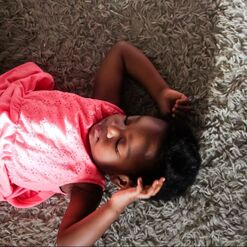|
One of the most common reasons that families reach out to me for consultations is to help them sort out their toddler's behavior. In these conversations there are some phrases that come up time and again. One of these is "It just comes out of nowhere." Or similarly, "It happens for no reason." I understand the feeling. Toddlers' reactions can often seem disconnected from the immediate cause. The intensity doesn't always match the perceived trigger. And to top it off, young children are generally not equipped to tell us why they felt the need to to throw themselves on the floor so dramatically when you suggested they put on their socks.
You might hear an "I don't like those socks!" but I have yet to come across a two-year-old who can express, "Well, I'm feeling ambivalent about going to daycare. I want to see my friends AND I'm sad to say goodbye to you. Sometimes it feels like a long time without you. As soon as my shoes are on I know we're on our way, so yeah... I don't really want to put on my socks." The thing is there is always something behind the behavior. Children's behavior is one of their primary forms of expression. The challenge for us as parents or educators is understanding what is being communicated. What need are they trying to meet? A very typical approach to dealing with unwanted behaviors is to focus on the behavior itself. Some families come to me having tried positive reinforcement techniques (praising desired behavior). Others have tried consequences or punishment to discourage unwanted behaviors. Most families I speak with have tried some combination of the two. These approaches are grounded in behaviorist theories of development. Behaviorist approaches aim to shape behavior. If they address underlying reasons, they do so only indirectly. In general, I find that at best they are effective only in the short-term. In response to these methods, the original behavior may morph into something else that looks very different, giving us the sense that the intervention worked when in reality the need is still being expressed. For example, a child may stop relying on hitting to communicate discomfort around a new sibling, but will seek to express their emotional needs through a newly challenging bedtime. The sleep disruption may then seem to "come out of nowhere," when in reality it is still tied to the feelings that led to the hitting in the first place. A different approach, the one I use with families and the one that current research in neuroscience and development supports, is to focus on understanding and addressing the needs behind the behavior. If their needs are met, the child no longer has to rely exclusively on unexpected or challenging behaviors to express themselves. It's not that these will suddenly disappear (a toddler is still a toddler), but they will fall away more easily without necessarily hardening into stubborn patterns. Even better, by seeking to address root causes, you will be strengthening your relationship with your child and growing everyone's capacity for empathy. Sometimes, stepping back to find the space and perspective to understand what is really going on with our toddlers can be hard. It can help to know about child development and common challenges at various points in development. It can help to put ourselves in our child's shoes for a moment and remember that when so much of your experience is new and few things are within your control, changes like a move to a big kid bed can be confusing and a big deal. And it can help to have someone who gets it to talk things through with. |


 RSS Feed
RSS Feed
